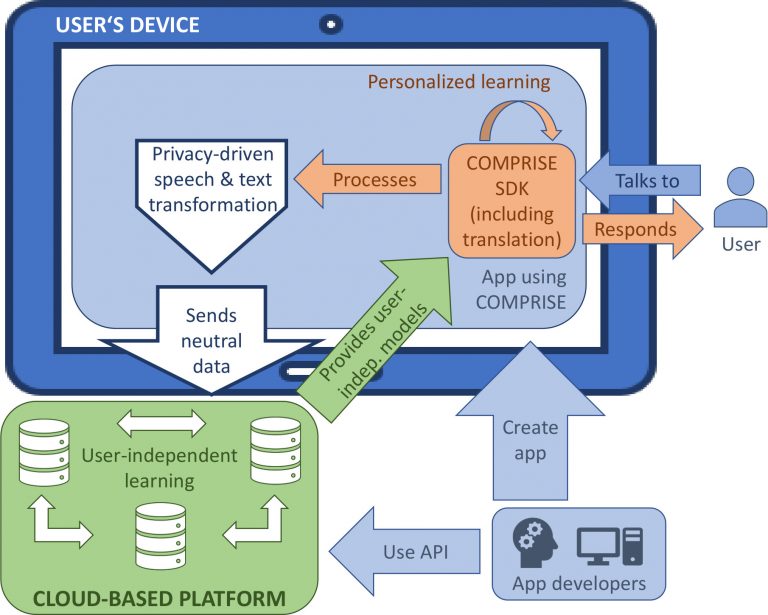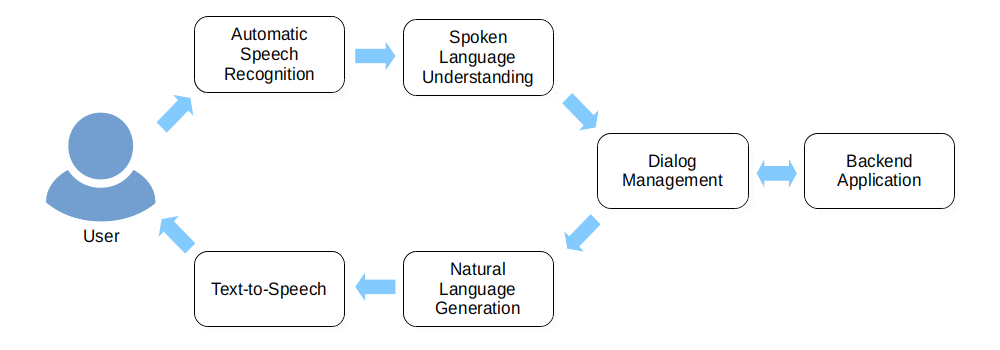
ΑΙhub.org
Working towards the next generation of voice interaction interfaces

COMPRISE (cost-effective, multilingual, privacy-driven voice-enabled services) is a European-funded Horizon 2020 project looking into the next generation of voice interaction services. The project aims to implement a fully private-by-design methodology and tools that will reduce the cost and increase the inclusiveness of voice interaction technology.
The research team have produced this video to outline the need for, and aims, of the project:
Spoken dialog systems – are they fully reliable?
Voice assistants like Alexa, Siri, and Google Assistant are still a relatively new technology for the consumer market. However, the research area of spoken dialog systems (SDS) has quite a long history. The classical architecture of a SDS typically looks something like this:
The user says something to the system, i.e., to her smartphone or to his smart speaker at home. Then, the system performs what is called automatic speech recognition, turning the sound waves that arrive at the built-in microphone into a sequence of words. At the next step, and through the spoken/natural language understanding component, these words get parsed and interpreted so that the system gets some idea of their meaning, i.e., what the user actually wants. Then, via the dialog management component, the system can react appropriately: if the user asked a question, it can try to find the answer; if it was a command, it can try to execute it. For that, it interacts with some backend application; for instance, a knowledge base, an e-commerce system, or anything else that is in charge of the stuff that is not directly related to the conversational aspects of the interaction.
Sometimes, the system might need (or want) to reply to the user, for instance in the case when a question was asked. To do so, the contents of the reply first need to be determined by looking for facts in a database, by searching the internet, or by another method. Once the reply has been determined, it gets depicted in the form of a textual representation via the natural language generation component. Then, the result must be turned into natural language so it can be communicated back to the user. Specifically, words have to be turned back into audio that sounds like a human voice, a task achieved via the text-to-speech component. All of these steps are illustrated in the following figure.

Based on the classical architecture description, it looks like the SDS functioning is very straightforward! But, is it really the case? Can it be considered as fully reliable? Let’s take a closer look.
There are a number of problems with this view of SDS, but for this article, let’s just focus on one of them, namely the problem that in general none of the steps represented by the upper boxes work absolutely reliably. If you have ever used automatic speech recognition before, you may have experienced that yourself: you speak into the microphone but the words that get written onto the screen are sometimes really not what you actually said.
Similarly, the interpretation of the words recognized by the spoken language understanding component may fail, and so on. And it’s not hard to imagine that when more than one of these components get it wrong, all the individual mistakes add up and the performance of the SDS suffers dramatically. It’s basically as if the boxes in the figure above were playing the children’s game of telephone (also known as Chinese Whispers).
In order to deal with this effect, modern spoken dialog systems use a trick that most children playing telephone would certainly consider cheating: each box does not just pass on to the next the best interpretation of their input but it considers multiple possibilities. For instance, the automatic speech recognition will not just output one sequence of words to the spoken language understanding component, but rather a list of sequences. Say, the user really said: “Find me a nice cafe around here.” Then the automatic speech recognition component might go: “I think I just heard the user say “find me an ice cafe around here” or “fine, me and ice cafe a round here” or “find me a nice cafe around here” or “find me a Nascar fee around here”. Good luck to the subsequent components!
One inherent problem with processing natural language is the large range of variation that you encounter. Take automatic speech recognition, for example: everybody’s voice is different, men have (on average) a lower voice than women, people speak with different accents, and then there are words and expressions that are used only in certain regions but not in others (“Hey, y’all!”). Or, take spoken language understanding: even the answer to a simple yes-no question can be expressed in so many different ways — yes, yeah, yup, uh-huh, hm, etc. For more complex utterances, it can get even more varied, yet the developer of a spoken dialog system is expected to program the system such that it can cope with most, if not all of these variations.
Well, before that developer can start programming, it would be a good idea to first collect some real-life data of people talking. The alternative — leaning back in your armchair and thinking really hard about how people talk — has proved to match reality so badly that it might be a feasible approach only for the most simple spoken dialog systems. Of course, no matter how much real-life data you collect, there is always a good chance of missing out on some important bits. In general, the more data of actual people talking you can get your hands on, the better your chances are of creating a robust system.
These data collections are not only useful for linguists to study how people converse. Manual data inspection is certainly handy for getting a feel about certain aspects of a dialog. But the task of writing some rules how a computer should process all the many variations of how people actually speak is still more than challenging. Wouldn’t it be better if the computer could somehow figure out by itself how to do that? Enter machine learning.
Supervised learning
On an abstract level, supervised learning can be illustrated with an analogy. Think of craftspeople who use a variety of different tools in their everyday work. Some of the tools allow various forms of settings for different kinds of jobs. And to get optimal results, the manufacturer might have designed the tool to come with one or more set screws that the experienced worker knows how to adjust.
Supervised learning can be seen as somewhat similar to that. The general task is this: find a way to map any valid input to some possible (and hopefully correct) output that we are interested in. For instance, for automatic speech recognition, the input would be the sound waves produced by the user when saying a sentence and the correct output would be the sequence of the words the speaker said. In order to achieve this, the designer of a supervised learning approach will first devise a general model of computation: this includes how to represent the inputs and outputs in machine-processable form as well as an algorithm that applies certain computation on the input to achieve some output. The idea is that this algorithm also contains some “set screws”, and these greatly influence the result of the computation. Except they are typically called parameters, not set screws. Set the parameters wrong, and the computed output will be garbage. Set them correctly, and you have a classifier that can assign the correct output to any given input with a pretty high probability.
However, even an experienced designer could not set all the parameters optimally by hand because unlike with tools, there are not just a few set screws to fine-tune; we are talking potentially about millions of parameters here. Turns out that processing natural language is more complex than jointing lumber. In supervised learning, there is thus a training phase whose purpose is to find a good value for each of the model’s many parameters. And that’s where the collected data comes in handy again. What we need is a large amount of examples. Each example consists of a valid input together with the correct output. By looking at these examples, a machine learning algorithm can automatically tune the model parameters until the outputs produced by the classifier become as close as possible to the correct outputs. Typically, before the training starts, the parameter values are initialized at random and, as the training proceeds, they are constantly adjusted. When the training is done, the best values have been found — hopefully.
Remember how we said above that the model should work for any valid input? That is the important bit here because it means that a trained model can also classify new inputs that have never been provided during training. Of course, there is no guarantee that such unseen inputs will be classified correctly — this depends mostly on what computations the designer put into the model as well as the parameter tuning that came out of the training phase. But the cool thing is that in principle, this is an answer to the problem of variation in natural language: with supervised learning, there is some hope at least that a lot more user utterances can be processed correctly than would be possible with traditional, rule-based programming. And so, the state-of-the-art in many natural language processing tasks is based on supervised learning.
Voice assistants: is someone listening to us?
In July 2019, the Flemish news outlet VRT published an article revealing that internet giant Google employs thousands of people around the globe to listen to recordings of the customers – mostly unbeknownst to them. This came as quite a shock given that an almost identical report was previously published by the American news outlet Bloomberg, and that had already caused quite a stir in April 2019 — except that, back then, it was another internet company employing the same practices: Amazon.
Both companies were recording their users’ voice commands through their respective smart speaker products, Google Home and Amazon Alexa. And both times, the stories were quickly picked up by other media, and within 24 hours, made international headlines. It is important to mention that the recording procedure complies with the law and company policies restrict what the people who listen to the recordings can do. Also, voice assistants are not meant to record human conversations but simple commands and they can do so only after hearing the “wake-up” word “OK Google” or “Alexa”. So why is this an issue? Well, the answer is quite simple: privacy is a concern when the user’s command contains some private information, or when someone else’s speech is overlapping with the command. It also happens that the voice assistant thinks it has heard the wake-up word even though it hasn’t been pronounced, and it records a conversation between several people instead.
It’s probably safe to assume that it must have come as quite a surprise, if not a shock, to some of the Home or Alexa users to learn that their voice is being recorded and somewhere, possibly miles away in a different country, someone may later listen to that recording. And not only that. The employees of these internet giants write down everything they hear for subsequent processing. As stated in the article published by the German online news outlet Spiegel Online, Amazon’s General Terms of Use do not mention this procedure at all, and the Alexa FAQs merely state the following:
“For example, we use your requests to Alexa to train our speech recognition and natural language understanding systems. The more data we use to train these systems, the better Alexa works, and training Alexa with voice recordings from a diverse range of customers helps ensure Alexa works well for everyone.”
As the VRT article suggests, Google Home users were equally unaware of these practices.
So, why would Google and Amazon even have any interest in not only recording their customers but also having their utterances transcribed as text?
Why would Google and Amazon want to collect and transcribe your voice commands?
Above, we sketched how voice assistants work and the key role that machine learning plays in modern voice-based systems. And there’s an old tongue-in-cheek saying in machine learning: “there’s no data like more data”. It makes sense because if your data collection is too small, it might give a skewed view of what the world is actually like, and so any model of this data would not necessarily be a good model of the real world.
With this in mind, we now have a pretty good idea about those companies’ incentives to not only record you when you talk to Home or Alexa, but even have employees transcribe your utterances: your commands are additional training data that will allow Google and Amazon to improve the components of their system that are based on machine learning. And as we’ve previously discussed, for supervised models, the raw data is not sufficient: the training data must also contain the actual targets that the model should learn. In the case of automatic speech recognition, these are the words contained in your speech signal. Hence, transcribing your utterances is simply the way to create the labels required to run supervised machine learning on the data collection.
Why would you care?
Now, if in the end your voice-based assistant is going to work better thanks to the training data you provided, shouldn’t that be a reason for users of smart speakers to be happy? Then why the massive backlash?
Well, supposedly no one would object to a system that performs better. The question is what price you have to pay for it, and here, price is not a monetary term. You are paying with your data. And this can potentially be problematic.
Part of the reason is also that few users were aware of the fact that Google and Amazon record them in the first place, and that they can have access to this data and request it to be deleted. Rather than an opt-out, wouldn’t it be better to make this an opt-in for the users?
Read more:
- Ford, M., & Palmer, W. (2019). Alexa, are you listening to me? An analysis of Alexa voice service network traffic. Personal and Ubiquitous Computing, 23(1), 67-79.
These blog posts originally appeared on the COMPRISE webpage:
Spoken dialog systems – are they fully reliable?
Voice assistants: is someone listening to us?
You can find all of the blog posts here.
The project team also has a YouTube channel for their videos here.









